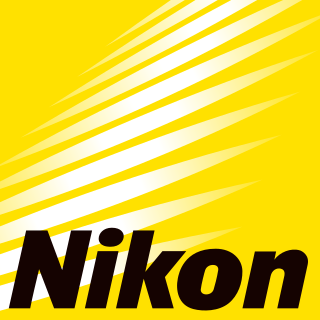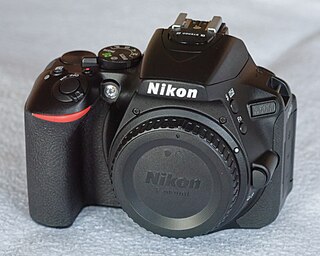A request that this article title be changed to Nikon Z6 is under discussion . Please do not move this article until the discussion is closed. |
 Z 6 + NIKKOR Z 24-70mm f/4 S | |
| Overview | |
|---|---|
| Maker | Nikon |
| Type | Full-frame mirrorless interchangeable-lens camera |
| Released | 23 November 2018 |
| Lens | |
| Lens mount | Nikon Z-mount |
| Sensor/medium | |
| Sensor type | Back-illuminated CMOS sensor |
| Sensor size | Full frame (35.9 x 23.9 mm) |
| Sensor maker | Sony |
| Maximum resolution | 6048 x 4024 (24.5 effective megapixels) |
| Film speed | Native range of ISO 100-51,200 (expandable to 50-204,800) |
| Recording medium | XQD card CFexpress card |
| Focusing | |
| Focus | Single-servo AF (AF-S) Continuous-servo AF (AF-C) Full-time AF (AF-F; only available in video mode) Predictive focus tracking Manual focus (electronic rangefinder can be used) |
| Focus modes | Pinpoint Single-point Dynamic-area AF Wide-area AF (small) Wide-area AF (large) Auto-area AF |
| Focus areas | 273 points (single-point AF) with 90% coverage |
| Exposure/metering | |
| Exposure | TTL metering using camera image sensor |
| Exposure modes | Programmed Auto [P] with flexible program; Shutter-Priority Auto [S]; Aperture Priority Auto [A]; Manual [M] |
| Exposure metering | TTL metering using camera image sensor Highlight-weighted metering: -4 to +17 EV (ISO 100, f/2.0 lens, 20 °C/68 °F) |
| Metering modes | Matrix metering Center-weighted metering Spot metering |
| Flash | |
| Flash | No built-in flash |
| Shutter | |
| Frame rate | Up to 12fps in 12-bit RAW and single-point autofocus |
| Shutter | Electronically controlled vertical-travel focal-plane mechanical shutter, Electronic front-curtain shutter |
| Shutter speeds | 30s - 1/8000s |
| Viewfinder | |
| Viewfinder | Quad-VGA (1280x960) EVF (3690000 dots) |
| Image processing | |
| Image processor | EXPEED 6 |
| White balance | Auto (3 types) Custom Cloudy Direct sunlight Flash Fluorescent (7 types) Incandescent Natural light auto Preset manual (up to 6 values can be stored, all with fine-tuning) Shade |
| General | |
| Video recording | 1080p video at up to 120 fps, and 4K video at up to 30 fps |
| LCD screen | 3.2-inch tilting TFT LCD with 2.1 million dots with touchscreen |
| Battery | EN-EL15b |
| AV Port(s) | USB Type-C, HDMI Type-C |
| Data Port(s) | IEEE 802.11b/g/n/a/ac/Wi-Fi, Bluetooth Low Energy |
| Body features | In-Body Image Stabilization |
| Dimensions | 134×100.5×67.5 mm (5.28×3.96×2.66 in) |
| Weight | 585 g (body only), 675 g (body with battery and memory card) |
| Made in | Japan |
| Chronology | |
| Successor | Nikon Z 6II |
The Nikon Z 6 is a full-frame mirrorless interchangeable-lens camera produced by Nikon. [1] The camera was officially announced on August 23, 2018, to be released in November. Nikon began shipping the Z 6 to retailers on November 16, 2018. [2] This was the second camera to use Nikon's new Z-mount system after the release of the 45.75 megapixel Nikon Z 7 in September 2018. [3]
Contents
This more-affordable 24.5 mega-pixel full-frame model offers nearly all of the same specifications as the Z 7. Aside from the lower resolution, differences include fewer phase-detection autofocus points (273 compared to 493) and an added anti-aliasing filter. The fewer mega-pixels allow for some benefits: a higher ISO equivalent, faster 12 fps (vs. 9 fps) drive speed, greater burst depth, and the ability to capture oversampled 4K video in full-frame up to 30 fps (and also in APS-C Crop, 10 MP APS-C still images can be captured) recording. [4] [5]
Three Z-mount lenses were available by December 2018, the Nikkor Z 24-70mm f/4 S FX AF, the 35mm f/1.8 S FX AF and the 50mm f/1.8 S FX AF. The F-to-Z mount adapter accessory allows for using Nikon lenses from the digital SLR series with full compatibility. [6] In late 2018, Nikon also published a "roadmap" of lenses to be released between 2019 and 2021. A total of nine products were included in that list. [7]
A DSLR version of this camera, the Nikon D780, providing similar auto focus performance and video performance, was released in January 2020.





























